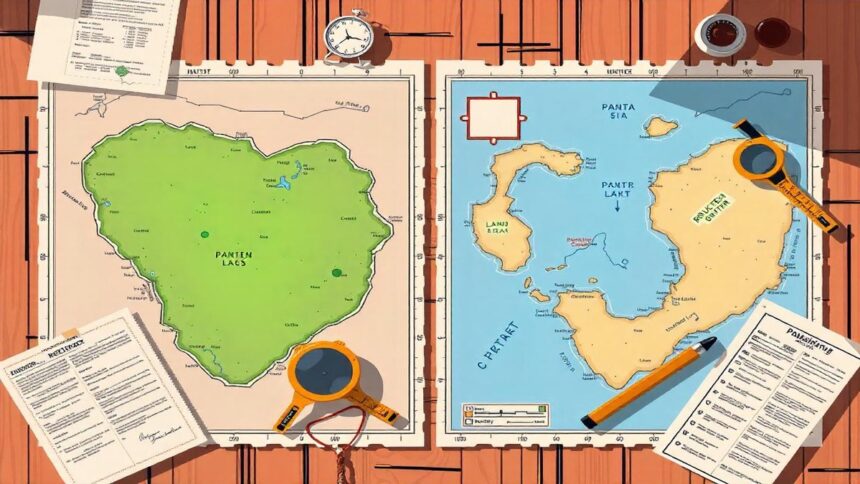Introduction When the size of your land as recorded in the patta (land ownership document) is less than its actual size, it can lead to numerous complications. Understanding the reasons behind this discrepancy and the steps to rectify it is crucial. This article outlines 21 essential aspects to consider when dealing with such issues.
21 Things You Need to Know
1. Initial Check: If your land size is correct on the ground and matches your purchase deed but shows a discrepancy in the patta, the first step is to verify the cause.
2. Typographical Errors: Check if the reduction in size is due to a typographical error in the patta. Compare the patta dimensions with the village A-register to see if they match.
3. Discrepancy in A-register: If the size in the A-register is also reduced, it indicates a measurement error. If the A-register shows the correct size, it is a typographical error in the patta.
4. Application for Correction: To correct a typographical error, submit an application to the District Revenue Officer (DRO) along with the A-register copy and other relevant documents to amend the patta.
5. Survey Verification: If the size is reduced in both the A-register and the patta, retrieve the survey map to verify. Ensure that the dimensions of your plot match the actual measurements.
6. Cross-Verification: If both documents show reduced dimensions, it’s not a measurement error. The error is only considered if the dimensions differ in the survey map and ground measurements.
7. Avoid Scammers: Be cautious of individuals who claim to correct the error for a fee without understanding the root cause. They may deceive you by showing false measurement errors.
8. Understanding Measurement Errors: Measurement errors often arise in three ways. Believing that surveys are always accurate is naive. Surveys can have errors, and the government has set tolerance limits for such discrepancies.
9. Government Tolerance Limits: Only if the land discrepancy exceeds the government’s tolerance limit is it considered an official measurement error. Do not rush to file an application for minor discrepancies.
10. Proper Evaluation: Determine if the error is due to a typographical error or exceeds the tolerance limit. Only then should you file an application with the district collector.
11. Procedure After Application: The district collector forwards the application to the local taluk office. A surveyor measures the land and prepares two maps, including the surrounding survey numbers, to verify against existing records.
12. Head Surveyor Review: The head surveyor reviews all documents and checks the survey maps for accuracy. They will also hold hearings to consider objections or support from neighbors.
13. Additional Corrections: If errors are found in the new maps, inform the taluk office in writing, and they will direct the surveyor to make corrections. If there are no errors, the documents are submitted to the district collector for approval.
14. Final Approval: The district collector approves the measurement corrections and orders the taluk office to update the village and taluk records.
15. Implementation: The corrected documents are sent to relevant departments, including the taluk office, village administration, and any involved land acquisition departments, for implementation.
16. Active Involvement: The government machinery does not operate automatically. You must actively follow up on the progress of your application at each stage.
17. Tolerance Limits: Understand the tolerance limits for measurement errors. For example, a 2-meter discrepancy per 200 meters for cultivated land and a 4-meter discrepancy per 200 meters for non-cultivated land are within acceptable limits.
18. Measurement Discrepancies: If the land size differs beyond these limits, only then can you apply for a correction. For instance, if a one-acre land shows a reduction of more than 5 cents, it qualifies for correction.
19. Area vs. Shape: If there is no discrepancy in length and width but the total area is reduced, it must exceed 5% to qualify for correction. Ensure the land shape matches the survey map to avoid shape discrepancies.
20. Shape Corrections: Understand that corrections will be made based on the actual shape on the ground, not the shape in the survey map.
21. Understanding Limits: There are no tolerance limits for shape errors. The land will be measured and corrected based on its actual shape.
Conclusion Addressing discrepancies in your patta land area involves understanding the causes and following a structured approach to corrections. Knowing the tolerance limits and actively engaging with the process can help ensure your land records accurately reflect your property. Be vigilant, verify documents thoroughly, and take prompt action to rectify any errors.
If you’d prefer to have everything handled for you seamlessly, you can click here and contact us at verified.realestate . Our team of experts is here to provide comprehensive support and ensure a smooth and secure property buying experience.
